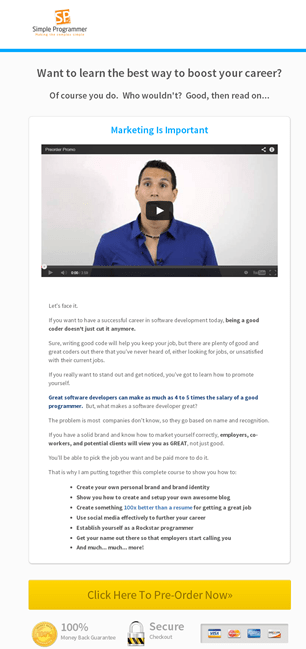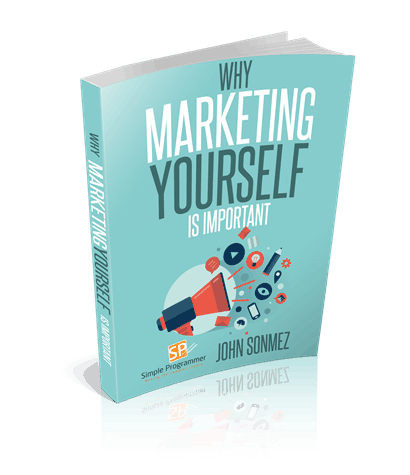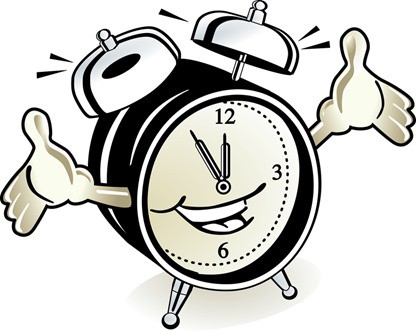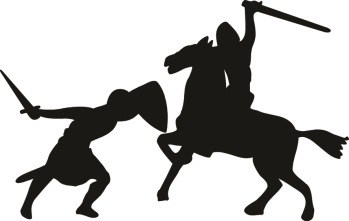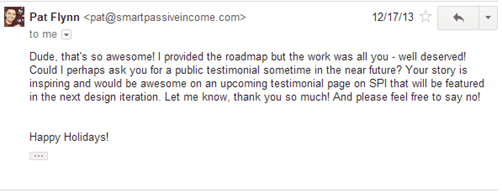This is the second in a series of three blog posts that are going to detail the events of the 24 hour, $100 challenge that two members of my mastermind group and I embarked on, from each of our perspectives.
- In the first post, Josh Earl, Derick Bailey and myself talked about what we thought about prior to the contest, how we felt and prepared mentally, and what we planned to do.
- In this post, we'll each talk about what actually happened when the clock ticked midnight on Dec 17th, 2013. And how we survived the 24 hour ordeal.
- Finally, in the last post, you'll hear the final outcome of the competition as we each discuss our results, break down what exactly we think we did right and what we did wrong, and how we would have done things differently.
My story
It begins!
The night before the contest I went to bed at 7:00 PM sharp. I had decided that I was going to wake up no later than 4:00 AM, but wasn't going to try and wake up at exactly 12:00 AM. My thinking was that if I tried to wake up at 12:00 AM and was still really tired, I would actually be less productive and get less done. I wanted to try to get as much sleep as possible, but still not waste any time. I really just needed to get my landing page up before other developers got up and went to work–at least here in the US.
I ended up waking up about 2:00 AM, but I immediately felt like I did not want to work on this project for 24 hours. As I walked from my bedroom to my office, I started to have some serious doubts about whether I could actually pull this off–this was going to be a long 24 hours.
I decided the first thing I should do would be to plan out my day in detail. I opened up Trello and created a new board called “$100 in a day.” I started making cards in the “To Do” column. The first card I came up with was “Pick and register a domain.” I'd need some kind of a domain to launch my new site on since I couldn't use my existing blog. After that, I added a card for “Set up a landing page on the domain.” I figured I could just setup a virtual private server at Digital Ocean and stand up a WordPress install on it. Then, came a card for “Plan what will go into the package.” I needed to decide exactly what I was going to sell. After that, was “Plan a pricing strategy.” Followed by, “Plan a giveaway for preordering” and “Make it possible to buy the package.” Finally came “Come up with the actual advertising plan.”
Setting up the landing page
I started out by looking for an expired domain that had a high Google page rank, since I figured this might help me to give the site a bit of a boost in search engine traffic, but I quickly realized that I would have to bid on domains and that process would probably take several days. Then, I remembered that I already had a domain called “devcareerboost.com” that I was planning on using as a sign-up page for my future course, so I might as well use it for the landing page for the preorder as well.
I quickly threw up a new WordPress install on a virtual private server I already had on Digital Ocean and I was ready to create my landing page. The only problem was, I didn't actually know how to create a landing page and I couldn't spend all day figuring it out. What I needed was a proven landing page format that already existed, which I could just fill in the text. I remembered hearing about Leadpages and decided to give it a shot. I signed up for an account and in a few minutes I was looking at the landing page templates Leadpages made available to me. I decided on one that allowed me to have a video at the top of the page and looked pretty good for selling a preorder.
My next problem was that I wasn't a copy editor. I really had no idea how to write good marketing copy for a landing page. I had written plenty of blog posts in the past, but writing marketing copy is a whole different beast. I decided my best course of action would be to try and modify the existing copy on the landing page template to suit my purpose. I also did a search online for some other long form sales pages that looked somewhat similar to mine. I tried to copy the tone of the examples I had and make mine look at least somewhat similar to theirs. I briefly considered hiring someone to do this part for me, but I realized that not only would I put myself in the hole money-wise if I did that, but I would also probably have to wait at least half of the day before I'd get the actual copy. I tried to not sound like a cheesy salesman, but I am pretty sure it still came out pretty cheesy. Oh well, at least I had something that might work. I could always modify it later.
I was starting to feel like I just might be able to pull this off, but I still had some big reservations about whether someone would actually click the buy button with all the cheesy copy I had just written.
Pricing the product
Next, I had to figure out exactly what was going to go into the package. I had figured that I would try and make the price-point be about $75, so I would only have to get two sales to make my goal. But, what could I produce that would be worth $75–on a presale that wouldn't ship for 3 months? I decided to take a look at other similar packages to get an idea of what people were including and what price they were charging for the content. I knew I would have to discount my price a bit, because I was doing a preorder and my landing page was not exactly “optimized.” I decided to check out Nathan Barry's site, since he had launched “The App Design Handbook” as a package and he had a similar audience to mine. I figured if I could provide at least as much content as the package that Nathan was successfully selling, then I could definitely ask a $75 price for it–at least while it was preorder, I could always raise the price later.
It turned out that Nathan had a complete package which included his flagship App Design Handbook, 9 video tutorials, 9 video interviews and 5 additional resources for $249. I decided to try and match that content by having a flagship book, “Why Marketing Yourself Is Important,” and including a couple of complete video courses, some smaller eBooks and a bunch of video interviews as well. I wanted to err on the side of including too much content rather than not enough. (I wasn't really thinking about how much would it would be later down the road to try and produce all this stuff in 3 months.)
By this time it was probably about 5:00 AM, but I was off to a good start. I filled in the details about the package on the landing page and put in the pricing information. Now, I just needed a way to actually take payments and deliver the product. I had already decided that I would probably use Gumroad for this, since they offer a really easy way to sell a product online. With Gumroad I could basically just put a link on my page that took customers to a checkout page and everything else was handled for me. I did need something to deliver to anyone who made a purchase, so I quickly created a Word document that simply said “This is a placeholder for the eBook you will receive within 24 hours. Thanks for your purchase!” (When you only have 24 hours, you do some pretty crazy things.)
Time to start marketing
I was finally ready to start seriously thinking about marketing. Now that I had a product that could be purchased, I needed to get the word out to as many potential customers as possible. I decided that I needed to work on the highest potential items with the least amount of effort first. My plan was to write up an epic blog post that would detail out a problem that my target audience faced. I decided that a large percentage of developers probably had faced the same kind of problem that I had faced in my career–a glass ceiling, where they couldn't really rise any higher or make more money. I wrote a blog post titled “Why You Are Stuck In Your Career” and I talked about how you have to be able to break away from the pack in order to advance past the glass ceiling. I talked about how famous chefs and rock-stars were talented, but were no more so than hundreds of others who were relatively unknown. I specifically called out the reasons why top chefs and top musicians were able to make more money than equally skilled, but unknown counterparts–they had built a name for themselves. I then pointed the reader to my solution to this problem–my course on how to market yourself as a software developer. I figured if I could get traction on that blog post, then I could get enough readers to my landing page to make at least a couple of sales. This would be my main marketing strategy–I needed this thing to go viral.
I decided the best approach would be to start by emailing as many influential developers as possible, explaining the contest and my blog posts to them, and asking them to help me spread the word by tweeting the post out to their followers and sharing it on their networks. I was comfortable asking this, because I had created a quality post that offered real value to anyone reading it. I didn't just ask them to tweet out my landing page, which would have been equivalent to just asking for handouts. It turned out this was quite successful and I immediately received back a few responses from some prominent developers willing to help me out.
Now that I had some eyes on the post, I figured there was a good chance the post would do well on Hacker News, so I submitted it there, opened up my real-time tracking in Google Analytics and waited. It didn't take long before the simultaneous viewers jumped from 2 to 30–the post was gaining traction. I checked and saw that it had been upvoted a couple of times, so even if it fizzled out, I should at least get some decent traffic. But, traffic is one thing and purchasing my $75 package is another. Would anyone actually click “buy?”
My first sale
My answer came pretty quickly. ** Within a few minutes I had my first sale.** I had to double check to make sure I was correct. But, it was true, someone had actually bought my product. A few minutes later another sale rolled in–I had already hit my target. Wow. I did not expect to succeed this quickly.
It was time to close down Google Analytics and figure out how far I could take this. Could I break $500 in a single day? $1000? I wasn't sure, but I was determined to find out.
My next idea was to start hitting popular developer forums and posting about the product. Unfortunately, I didn't really know many developer forums. I tried a few Google searches and didn't come up with much. I thought perhaps I could submit my post to Code Project and see if that got any traction, but the post got rejected, because it contained advertising for my product. I registered for forums and posted some information about my product and a link to my blog post, but I didn't really get much traction, since I was basically looking like a spammer. ** You really need to build a reputation in most communities before you can promote something of yours there.** I hadn't really thought about this when I was planning out my strategy.
I decided that I should check to see if I could get an email list of developers that I could mass mail a message about my package to. I knew that I should be able to buy targeted email lists, but I wasn't sure exactly where or how to do it. I figured my best bet was to try looking for someone on oDesk who could send an email to 1000 developers. I put up a job request and explained what I wanted done. Then, I moved onto other activities, since it would take awhile for someone to get back to me.
Slowing down
I was at a loss for what else I could do. It was only about 12:00 and I was pretty much out of marketing ideas. Other than directly contacting people one-by-one on Facebook or Twitter, I couldn't think of another way to spread the message. Everything else I came up with involved reaching out to people individually and that kind of thing would not scale. I knew that I needed about 100 to 200 people to hit my landing page for every sale that I was going to make. By this time, I had gotten a few sales and I started to figure out an estimated conversion rate.
I decided that I would try the thing that had worked the best so far and write another blog post framing a problem and then offering a solution. I wrote up another blog post titled “Why You Aren't Paid As Much As You Are Worth.” This one talked more about the idea of most software developers being a commodity and how you could differentiate yourself through marketing to become more than a commodity. I pointed out the solution to this problem is knowing how to market yourself and I included a link to my landing page where I offered to sell the solution for just $75. I felt like the post was pretty good, but it sort of fell flat. It didn't get much traction from Hacker News or Reddit. (Possibly due to the fact that I had just written about that topic earlier that day.)
I had one last idea before I would give up and start writing the book that I needed to ship in under 24 hours–Google+ communities. I figured I might be able to find software developer communities on Google+ that I could join and drop a link to the first blog post I had written that had done well that morning. I joined about 30 communities and put my post out there. It turned out to be a pretty good idea, because I did start seeing traffic from Google+–not as much as Hacker News had generated, but it was something.
Writing the book
I decided the best use of my time at this point would be to write that book, because if I didn't get a first draft out by the next day, I'd be issuing lots of refunds. I started writing like a madman, but of course it was pretty easy to write about the subject, because I had spent all day thinking about it and had already given several talks about marketing yourself as a software developer. I stopped to eat dinner, but then went right on back to writing.
I took a break in the evening to check up on oDesk. It turned out that I got several responses from freelancers that could get me a list and send the emails out, but it didn't look like anyone could meet my time line. I was a bit hesitant about this approach anyway. I didn't feel like this was the same as “cheap discount Viagra,” but it still felt a little spammy. Not an approach that I would have done normally, but I figured for competition sake, if I could pull it off, I might as well try. I ended up talking with the most hopeful prospect, but it turned out to be a bust.
I pretty much spent the rest of the night frantically writing my eBook. I finished the last chapter of the first draft at about 10 minutes till midnight with a total word count of around 12,000 words. Between the book and the two blog posts, I had written about 15,000 words that day. I didn't have any trouble falling asleep that night. (Mind you, this was only the first draft of the book. I spent much more time adding content and revising this draft over the next few weeks.)
Derick’s Story
I did not sleep well, the night before the challenge. Sure, I went to bed at 9pm – but what does that matter when you don't get to sleep until 10:30, and that sleep is more like tossing and turning all night? The fear, the anxiety, the doubts all raced through my mind. I eventually did get to sleep, but my plan of waking up at midnight to get started was already looking like a bad idea.
Today's Tasks
When the alarm finally did wake me up, it was 4am instead of midnight: first fail of the day. I was four hours late getting started. But I crawled out of bed, got some food and sat down at my desk to get rolling. I had two things to do this morning:
And right here, right now, I have failure #2: I bailed on the website to shamelessly ask for money. I just couldn't bring my self to do it. My stomach was twisting and turning as I was about to click the buy button on a domain name.The fear of being called out, told I'm a scamming fraud and marketing sleezebag got to me. Combine that with only a few hours of sleep, and I bailed on the first thing that could have made me some money. Of course I justified it to myself. I told myself it was ok to bail because of waking up 4 hours late. It's easy to justify things like this. There's always an excuse. What isn't easy is admitting that you bailed for fear and self-loathing – but that's exactly what I did. I regret not doing this, not having tried and seen what it may have brought.
Getting Started On The eBook
I pushed that website aside and got cracking on my eBook for podcasting. I've been using LeanPub.com for ebooks already, so it was a simple thing for me to get another one started. I created an empty shell of the project, gave the book a name, waited for my dropbox folder to update and started cranking out the book by designing the cover, first. It was important for me to have the cover because Leanpub will show the book cover on your page, after you generate your first preview of the ebook. Having a good cover can make or break the first impression when someone hits your leanpub page. I've dealt with bad covers in the past, so I wanted to make sure I had one that would stand up to that first impression this time.
A few weeks prior, I had bought a bunch of credits on depositphotos.com and it was paying off now. A few quick searches later and I had a great image for a book cover, that didn't need too much added to it. All together, I think I spent an hour getting the cover put together. Combine that with the 30 minutes to get Leanpub set up and another 30 minutes to put together a very rough chapter outline, and I had my first ebook preview generated in a couple of hours. With the preview generated, and the book cover showing on the Leanpub page, I set a suggested price of $10 and got started on the real content.
Cranking Out Content
The next few hours were a mix of cranking out content, combined with combing DepositPhotos for the perfect images to illustrate what I was saying. It was a caffeine fueled joy-ride, and what a caffeine rush it was! At this point, I had been off caffeine for nearly a month. So the one 12oz can of Diet Mountain dew that I had around 7am gave me a massive buzz and really helped me push through the long day. I wrote a total of 4 chapters for the book that morning, added a number of images to the chapters, and previewed the ebook through leanpub multiple times.
About halfway through the morning, though, I had to step back and re-formulate the name and chapter outlines. I realized that my book had gone too far down in to the weeds of recording and editing, but didn't cover enough of the planning or publishing side of things. It took about an hour for me to redo the leanpub setup and the book cover. This was an hour that I should have spent on content, but it was a necessary chunk of work so that the book would make more sense. In the end, I'm glad I made the change.
By the time 12 noon rolled around, I had 4 chapters and a book that would at least get people to record a first podcast episode. I was read to stop writing and start working on the marketing side of things.
The Marketing Effort
All that fear, all the anxiety… everything that I hated about this challenge came right back up front and center when I hit publish on the book for the first time. Now, suddenly, I don't have a concrete thing to build – something to distract me from the work that I was dreading. Now I have to face my fears and anxiety, and try to actually sell this thing? What the crap am I supposed to do, here? How am I supposed to sell this? Well, ok. I've done this before with my screencasts. I've engaged an audience and convinced them that what I have is worth some money, through twitter and blogs. So I'll start there. I'll blog about the book. I'll setup a web page at http://blog.signalleaf.com/how-to-podcast, and I'll use that as the landing page and marketing copy. The blog post will follow, and will be an announcement / introduction style, while the landing page itself will be the real marketing copy.
It took me nearly an hour to get the landing page built, get the book image added to the sidebar of the blog, add the menu link at the top of the site and build that big green “buy now” button for the page. I think 20 minutes was spent on that button alone. I had such a hard time getting it to look and behave the way I wanted. But in the end, I had the page and I had a blog post to announce the book. Now how do I get it in front of people?
I turned to twitter, my old friend. I've done this before so why not do it again? Only this time, I can't use my @derickbailey account. I can only use my @signalleaf account. For the next few hours, then, I was combing through twitter searches, looking for people that were asking about how to start a podcast. It's actually quite surprising how many people are asking about this, on a daily basis! I had no shortage of tweets to which I could respond. What I had a shortage of, however, was courage. My stomach was again turning in circles. So I did what any other marketing n00b would do: I went and got lunch instead of doing the marketing. I had to eat, right? Let's do that instead of doing the hard work.
The Sales Pipeline
When I got back from lunch, I had no more excuses. I had to actually reply to people on twitter and start engaging them. So that's what I did. I started by tweeting my blog post about the book, of course. But I had so few followers that it wouldn't matter. So I went back to my twitter searches and started trying to find ways to talk people in to buying the book.
I've never believed in “sales”. I've always believed that if I'm truly passionate about something, and that I have something valuable, people will see it and want it. It's natural for me to talk about the things I love, and people will gravitate toward that. I do this all the time in blogging and in software development. But I quickly found out that this wouldn't make a meaningful dent in my goal of earning $100 in one day. Sure, my engagement of the twitter crowd did produce some great conversations. I found some good podcasts, found a lot of great people who wanted to get started, and answered some questions. I used twitter as a method of engaging the people who would benefit from buying this book. But I never once tried to sell the book, and so I never actually sold any that day. The closest I came to selling a book was when I gave a free copy to a podcaster. I was hoping that she would like the material I was producing, since she was also producing “getting started” material in her podcast. That never panned out, though. Even after conversations on twitter went well, she did not download the book until a few days later – long after the contest had ended.
Closing My Day: $0 Earned.
Throughout the afternoon, I continued to work on the book. I looked for blog posts that I could comment on, to link back to me. I engaged twitter. I did a lot of things that would build long term credibility, basically. And halfway through chapter 5, I also realized that I needed better info on MP3 bit rates, audio quality and file size. This prompted me to record a short podcast, which I extended in to a 32 minute episode and exported at 10 different bit rates. The results of this experiment, showing the effect of bit rates on file size and audio quality, are found in this blog post: http://blog.signalleaf.com/blog/2013/12/18/mp3-bit-rates/ By the time the end of the day rolled around (and I do mean “end of day” – I stayed online until midnight, tweaking the book, engaging more people via twitter, and generally trying to build my audience) – I had sold nothing, but I had at least gained a great asset that would be an introduction to world of podcasting, for others. That in itself was a success. The challenge day: fail. I earned nothing, and therefore failed the challenge. I emailed Josh and John, let them know my results for the day:
- 7K+ words written
- 5 chapters of a brand new book
- 1 book cover design, with a dozen or more image manipulations for the book pages
- 1 web page / book page and
- 2 blog posts
- 10 exports of a single podcast episode, with a complete RSS feed for the special-edition podcast
- 2 comments on relevant blog posts, with 1 link back to my blog
- several conversations engaged on twitter
- give away 1 copy of the book to a person on twitter (who has yet to claim it)
- 1 tweet from a podcast that I'm sponsoring, about my book
- 16 unique visitors to the blog
- 1 new trial account signup (though I think it's not going to go anywhere, I’m happy to have another trial signup)
- 0 sales, $0 income and 0 email list signups for Signalleaf
I did end up selling 1 copy of the book, by the way. But it wasn't until after 1am – an hour after the challenge ended. So that $10 did not count toward my goal for the day. Since then, I've made the book “free” for signing up on my mailing list, I've added a number of checklists to to appendix, and having given away around 20 copies. The book itself is not yet finished, but it's a great start and something that I will be working on throughout the rest of 2014.
Objectively, the day was a failure. The goal was to generate income and I completely, utterly failed at that. Long term, the day was an outstanding success. I set in motion a ton of things, completed a number of my commitments for the week, and had a ton of fun staying up for 22 hours, hacking away on things! :D If this were re-branded as a marketing hackathon day, I would be in strong standing with a good chance of taking home first prize. I kicked ass on creating new content, producing material that is tremendously valuable to the podcasting community, and engaging the community through blog posts and podcast episodes. It was a good day.
Josh’s Story
Battle plan
I didn't sleep very well. My brain was looping relentlessly, rehashing my plans for the challenge.
When I finally got up, around 4 a.m., I didn't feel great. No, scratch that, I was miserable. I was a weak-kneed, sour-stomached ball of anxiety.
Still, I got up, took my usual morning shower, and settled down to work around 4:30 a.m.
My battle plan was simple. It all hinged on writing a killer blog post, then ensuring that this post was a hit that attracted thousands of visitors to my site. I'd use this burst of exposure to build a small email list by offering a giveaway related to the topic of my post. Then I’d use my experience with email marketing to my advantage to sell … something … and win the day!
To make this work, I’d need to write a blog post, set up a mailing list opt-in form, promote the post, settle on a product, write a sales page, write the giveaway I was promising all of the people who were joining my list, and send out the email that would bring in the sales. The audience was more important than the product; with enough traffic, I should be able to sell whatever I came up with …
Off to a rousing start
The blog post was the linchpin, the key to the entire day. There was a lot riding on it. My plan called for me to finish it by 7 a.m. so I could publish it on Hacker News before the site got too busy, maximizing my chances for a front page hit.
So naturally the first thing I did when I sat down at my desk was … start researching the product I was going to offer. Particularly, what tools I would use to create it. Typical software developer…
I was considering two different options for the product. I didn’t want to presell something that I’d have to spend weeks creating, so I’d settled on doing some kind of live event. My blog post was going to be about the success I’ve had marketing my Sublime Text book over the last 12 months, so I thought I could try to sell either some 1-on-1 coaching-type sessions with aspiring self-published authors, or else a webinar-format event where I walked participants through what I’ve done to promote my book.
Like many developers and writers, I’m an introvert, and just thinking about doing either of these events made me a little sick. I let this anxiety immediately derail my plan.
After an hour or so of comparing software platforms, I decided that I’d offer seats to a private Google Hangout, and I’d use Eventbrite to sell the tickets. This didn’t help my anxiety much, but at least I knew what I was going to be selling.
Reverse-engineering success
With that research out of the way, it was time to get writing. The post really was important, and I needed to get it out stat.
Sounds like a good time for … more research!
I spent the next 30 minutes or so reviewing popular posts on Hacker News, particularly Nathan Barry's always popular book launch postmortems. He devotes a lot of space to numbers and specifics, I noted, and his posts are heavy on charts and graphs, along with some analysis of what went right and what went wrong. I also dissected the headlines he used—the headline is by far the most important contributor to the success of a post.
Unlike my first research excursion, this was time well spent. I could have been much more efficient, though, because …
By the time I finally cracked open Sublime and started writing it was 6:31 a.m.
That 7 a.m. deadline wasn’t looking too good …
I average around 800 words an hour when I’m in a groove and working on a focused topic with a good outline. Unfortunately, I was about as far from those ideal conditions as possible.
To start, the topic was very broad—I was going to try to cover more than a year of sales ups and downs in one post. There was my nervousness about pretending to know something about marketing when there are so many truly skilled marketers out there. What if they laughed at me or left mean comments?
And then there was this truth: I secretly hoped I’d fail. Putting myself out there in this post was bad enough, but success meant I’d have to go through with the live event, which was an even worse prospect.
My writing discipline crumbled. I broke all my rules. I researched as I worked. I didn’t write a thorough outline. I didn’t write a first draft without editing. I scrolled, I tweaked, I revised.
And the results were predictable. It turned out to be a good post, 2,035 words long, with a half dozen graphs and charts to break up the wall of text and prove my results. But it took six hours to produce, and I didn’t push the publish button until 12:34 p.m.
Emotionally drained, I posted the link on Hacker News and Reddit and went to lunch.
My fate was in the gentle hands of Hacker News
Google Analytics is pure productivity Kryptonite. Especially since they added the realtime current visitors counter.
All through lunch, I kept an eye on that counter to see what my fate would be. Would Hacker News take an interest in my post, or would it quickly disappear under a pile of NSA revelations?
For a few minutes, it looked like it was going to catch. My simultaneous visitors count climbed to the upper single digits. I know from past experience that this is the make-or-break point—if you don’t get into double digits within the first few minutes, your post will probably only going to get a couple of hundred visits from Hacker News.
Then the counter started to drop.
A feeling of relief washed over me. Without a traffic surge from Hacker News, there was no way my plan could work.
Oh, well, I’d given it my best shot, and I’d failed. Now I could relax and not worry about the contest.
It's all over. Right?
When I got back from lunch, I decided I should at least go forward with some of my plans to promote the post—no sense letting my work go completely to waste.
I sat down and started sending emails. I planned to individually contact each of the influential people I mentioned in the post and thank them for helping to make my success possible. I included a link to the post but did not specifically ask them to share it. My list of influencers included Peter Armstrong of Leanpub, Pat Flynn, Nathan Barry, and Jesse Liberty.
As I worked, I noticed my Google Analytics counter start to creep up again. My post seemed like it was showing some signs of life on Hacker News. Uh oh…
Then it shot up like a rocket—now more than 120 people were reading the post at once! I’d hit the front page, and I was getting hundreds of new hits every few minutes.
I was back in the game! I was still sick with anxiety, but this traffic spike gave me the courage to keep going. I sent a few more emails to friends and acquaintances, asking for a tweet or a like.
The responsesstarted arriving. Peter Armstrong responded and said he’d tweeted the article three different times. Moreover, he was wondering whether I’d be interested in allowing him to republish it on the Leanpub blog. That was my first invitation to guest post—I was stoked! It wouldn’t help me with the contest, but it would help me build traffic long term to my blog. Jesse Liberty replied to let me know he tweeted the post.
But my biggest shock came when I emailed Pat Flynn—and got a response two minutes later!
I was convinced I’d triggered a reply from a crafty autoresponder—Pat is a ninja with clever productivity hacks like that. I replied that I’d be happy to offer a testimonial, then asked for a tweet or Facebook post. And he responded again:
Score! Pat’s audience was a perfect fit for the topic of my post and seemed likely to be interested in my self-publishing Hangout.
After a couple of hours of promotion, I was running out of people to contact.
But was it working?
By this point, the blog post had generated a couple of thousand visits. That part of my strategy was working as planned, but was I getting the email signups I needed to be able to sell seats to my Google Hangout?
I logged into MailChimp to find out.
Oh, not good. Traffic was trending down, and I’d only gotten 9 subscribers. Hacker News traffic doesn't usually convert well to email sign ups—I was prepared for that. But I had hoped that a front page hit would bring in enough volume that I'd still get 5 to 10 times as many subscribers as this.
After considering my options for a few minutes, I decided that I needed to change gears. This indirect approach wasn’t going to get me the numbers I needed—I had to pitch the Hangout directly at the end of the post, where it would be seen by more people.
But first I had to get the event scheduled. I jumped over to Eventbrite and fumbled my way through creating tickets for an online-only event. I settled on a price of $25 per seat, which would allow me to make $23.97 profit per sale. I'd need to sell five seats to hit my goal.
Now that I had a link, I updated the call to action in my post: Instead of encouraging readers to sign up for my email list, I promoted my self-publishing Google Hangout.
Running out of gas
It was 2:58 p.m. when I finally started promoting my event. Was it too late? I needed more traffic, but I was getting low on ideas. My personal network was tapped out, and I'd implemented my best “instant traffic” tactics.
While I waited to see if my updated call to action would net any sales, I started looking for other places to promote my post. I jumped on to Facebook, where I belonged to a self-publishing group run by Pat Flynn, and posted a comment about my post there. This generated several questions and responses, which I responded to.
I googled phrases like “self-publishing” and “marketing an ebook,” looking for highly ranked blog posts that would allow me to add a useful comment and a link back to my post, naturally. This didn't seem likely to help me out much in the contest, but I knew it would create a small but steady stream of traffic to my blog in the future.
And a sale!
At 4:53 p.m., my efforts paid off—an email landed in my inbox informing me that I had sold a seat to my Hangout! I was relieved. At least I was in the game. How many more sales would I be able to get before midnight?
I was now officially out of ideas for promoting the post, so I decided to break for dinner and some family time.
More resistance?
The resistance that I battled all day returned with a vengeance when I sat down to tackle my last task for the day—creating the giveaway I'd promised to get readers to sign up for my mailing list. Would this list of tools even be useful to anyone? The whole idea seemed stupid. People were going to be mad at me when they got it.
But I'd committed to putting it together, and I really didn't want to leave this task hanging over my head, so I forced myself to start working on it.
I'd planned on about 30 minutes for this, so of course it took more like 90. I finished it at 8:32 p.m. and decided that I was done for the night.
Before I put away my laptop, I decided to check Google Analytics one more time. Whoa, my realtime counter said I had 60 people on my site! Pat Flynn's promised tweet had just hit. Another nice burst of traffic to wrap up the day.
I turned out the light, knowing full well that Derick and John were still cranking away. But after a day of wrestling my inner demons, I didn't much care. I'd executed my strategy. I'd survived. I'd made some money.
Was it enough?
Grand finale coming up
Want to find out what happens next? In the last post in this series, we’ll each talk about what the final results were and what we learned from the experience. Sign up here to make sure you don’t miss that next post.


